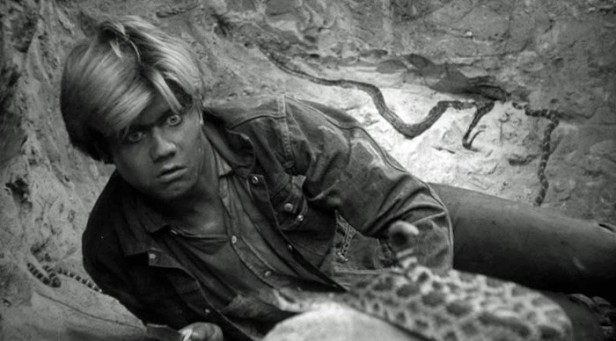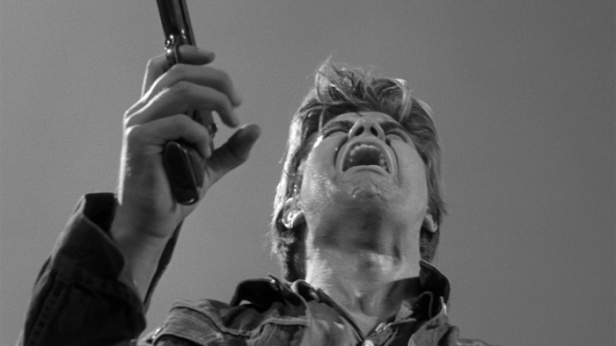Following the likes of The Choppers (1961), Eegah (1962) and Wild Guitar (1962), actor and singer Arch Hall Jr stepped out from the shadow of his father Arch Sr who had produced, written and/or directed most of his earlier work and ended up giving the best performance of his career as the eponymous maniac in James Landis’ stylish low-budget shocker (which sometimes sports the title Sweet Baby Charlie). The story, penned by Landis under the title 12:01, takes its inspiration from the killing spree committed in December 1957 and January 1958 by 19-year-old Charles Starkweather who, with his 14-year-old girlfriend Caril Ann Fugate murdered ten people, mostly total strangers shoe paths they just happened to cross, though they started his killing spree with Starkweather’s own parents and Starkweather alone had killed another man three months earlier).
Here, the youthful killer is Charlie Tibbs (Hall Jr) who, with his barely communicative girlfriend Judy (Marilyn Manning, who had co-starred with Hall Jr in Eegah), menaces a trio of high school teachers, Ed (Richard Alden), Doris (Helen Hovey), and Carl (Don Russell), who have become stranded at a remote junkyard/gas station when their car breaks down. Charlie and Judy have been murdering their way across the southern States from Arizona and have wound up in California’s Antelope Valley. At gunpoint, Charlie demands that Ed finishes repairing the car so that he can steal it and continue his flight from the police, threatening to murder them if he doesn’t comply. Charlie and Judy humiliate and abuse the teachers, eventually shooting Carl in the head in perhaps the film’s most shocking moment. A battle of wills follows as Ed and Doris try to outwit their murderous counterparts and stay alive. The bulk of the story plays out in real time, which only adds to the already considerable tension.

The use of a single location, the out-of-the-way junkyard, is claustrophobic and highly effectively used by Landis and particularly by cinematographer William (Vilmos) Zsigmond here at the very start of his career – it was his first gig on a feature film, and he was already showing some of the talent that he would later bring to bear on films like McCabe & Mrs. Miller (1971), Close Encounters of the Third Kind (1977), The Deer Hunter (1978) and Heaven’s Gate (1980). It’s a beautifully shot film and the use of silence plays an important part in ratcheting up the tension, which Landis wrings more from the limited location than you might expect.
Hall Jr is something of a revelation here. It’s true that his performance still has some rough edges here and there, but Landis seemed to bring out something good in him, something we hadn’t seen in his earlier work. Tibbs is one of the most loathsome characters in any 60s film, a thoroughly unpleasant and brutal monster who more than justifies the title. You do come to believe that you’re in the presence of a genuinely dangerous and psychotic maniac, such is the full-on intensity of hall’s barely contained performance.

The Sadist can now be seen as an early example of a theme that would become popular in later years, that of the city folk ending up somewhere horrible, somewhere they don’t belong where awful things are done to them by monstrous people. As such it’s not much of a stretch to see The Sadist as very much a predecessor films like The Last House on the Left (1972), The Texas Chain Saw Massacre (1974) and The Hills Have Eyes (1977).
The Sadist remains the single most impressive title in Landis’ short filmography. As a director he went on to make the spy comedy The Nasty Rabbit in 1964 (also starring Hall Jr) which has picked up a cult following and wrote and directed the crime drama Rat Fink a year later. Some seem to have mistaken the latter for Ray Dennis Steckler’s superhero film Rat Pfink a Boo Boo (1965), which is clearly not the case, though Halls Sr and Jr had earlier worked with Steckler on Wild Guitar. Landis’ career was over by the end of the 1960s but in The Sadist he left behind an unvarnished little gem that has, in more recent times, finally started to get the attention it deserves. Joe Dante is a particular fan, owning his own 35mm print of the film and waxing lyrical about its ghoulish charms on many an occasion.

The Sadist was released on a double bill with the vastly inferior (and barely even horror) Anatomy of a Psycho (1961) by Hall Sr’s Fairway International Pictures, and was clearly the better half of the bill. Later, the Starkweather killings were later revisited by Terrance Malik in his classic Badlands (1973), Dominic Sena in Kalifornia (1993), Oliver Stone’s Quentin Tarantino-scripted Natural Born Killers (1994) and Byron Werner’s biopic Starkweather (2004), while Bruce Springsteen’s 1982 song Nebraska also re-tells the story of the murders in musical form.